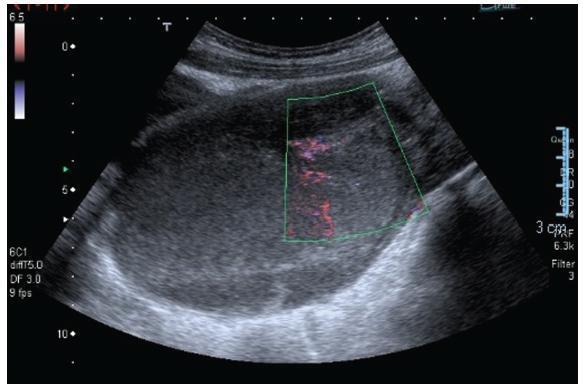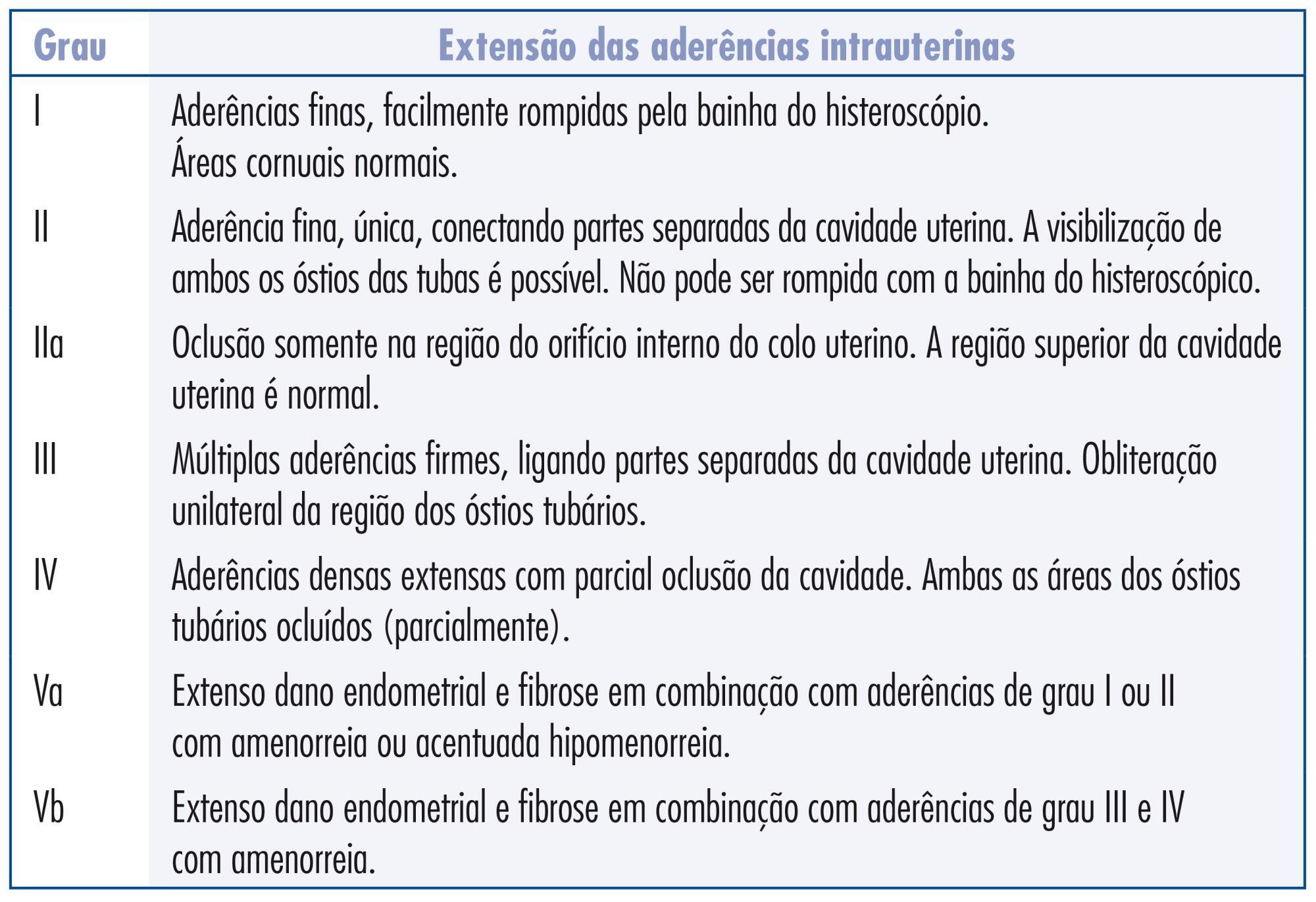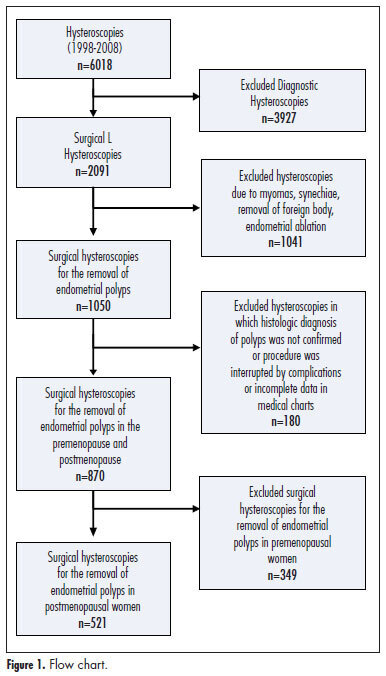Summary
Revista Brasileira de Ginecologia e Obstetrícia. 2018;40(10):642-646
Transverse vaginal septum is a rare female genital tract anomaly, and little is described about its surgical treatment. We report the case of a patient who wished to preserve hymenal integrity due to social and cultural beliefs. We performed a vaginoscopic resection of the septum under laparoscopic view, followed by the introduction of a Foley catheter in the vagina, thus preserving the hymen. After 12 months of follow-up, no septal closure was present, and the menstrual flow was effective. Vaginoscopic hysteroscopy is an effectivemethod of vaginal septum resection, even in cases in which hymenal integrity must be preserved due to social and cultural beliefs.

Summary
Revista Brasileira de Ginecologia e Obstetrícia. 2016;38(10):506-511
To evaluate the accuracy of transvaginal ultrasonography, hysteroscopy and uterine curettage in the diagnosis of endometrial polyp, submucous myoma and endometrial hyperplasia, using as gold standard the histopathological analysis of biopsy samples obtained during hysteroscopy or uterine curettage.
Cross-sectional study performed at the Hospital Universitário de Brasília (HUB). Data were obtained from the charts of patients submitted to hysteroscopy or uterine curettage in the period from July 2007 to July 2012.
One-hundred and ninety-one patients were evaluated, 134 of whom underwent hysteroscopy, and 57, uterine curettage. Hysteroscopy revealed a diagnostic accuracy higher than 90% for all the diseases evaluated, while transvaginal ultrasonography showed an accuracy of 65.9% for polyps, 78.1% for myoma and 63.2% for endometrial hyperplasia. Within the 57 patients submitted to uterine curettage, there was an accuracy of 56% for polyps and 54.6% for endometrial hyperplasia.
Ideally, after initial investigation with transvaginal ultrasonography, guided biopsy of the lesion should be performed by hysteroscopy, whenever necessary, in order to improve the diagnostic accuracy and subsequent clinical management.
Summary
Revista Brasileira de Ginecologia e Obstetrícia. 2014;36(4):170-175
DOI 10.1590/S0100-720320140050.0001
To examine the aspect of the uterine cavity after hysteroscopic endometrial ablation, to determine the prevalence of synechiae after the procedure, and to analyze the importance of hysteroscopy during the postoperative period.
The results of the hysteroscopic exams of 153 patients who underwent outpatient hysteroscopy after endometrial ablation due to abnormal uterine bleeding of benign etiology during the period from January 2006 to July 2011 were retrospectively reviewed. The patients were divided into two groups: HIST≤60 (n=90) consisting of patients undergoing the exam 40-60 days after the ablation procedure, and the group HIST>60 (n=63) consisting of patients undergoing the exam between 61 days and 12 months after the procedure.
In the HIST≤60 group, 30% of the patients presented some degree of synechiae: synechiae grade I in 4.4% of patients, grade II in 6.7% , grade IIa in 4.4%, grade III in 7.8%, and grade IV in 2.2%. In the HIST>60 group, 53.9% of all cases had synechiae, 3.2% were grade I, 11.1% grade II, 7.9% grade IIa, 15.9% grade III, and 4.8% grade IV. Hematometra was detected in 2.2 % of all cases in group HIST≤60 and in 6.3% of all cases in group HIST>60.
The uterine cavity of the patients submitted to diagnostic hysteroscopy up to 60 days after endometrial ablation showed significantly fewer synechiae compared to the uterine cavity of patients who underwent the exam after 60 days. Long-term follow-up is necessary to fully evaluate the importance of outpatient hysteroscopy after endometrial ablation regarding menstrual patterns, risk of cancer and prevalence of treatment failure.

Summary
Revista Brasileira de Ginecologia e Obstetrícia. 2013;35(6):243-248
DOI 10.1590/S0100-72032013000600002
PURPOSE: To evaluate the accuracy of sonographic endometrial thickness and hysteroscopic characteristics in predicting malignancy in postmenopausal women undergoing surgical resection of endometrial polyps. METHODS: Five hundred twenty-one (521) postmenopausal women undergoing hysteroscopic resection of endometrial polyps between January 1998 and December 2008 were studied. For each value of sonographic endometrial thickness and polyp size on hysteroscopy, the sensitivity, specificity, positive predictive value (PPV) and negative predictive value (NPV) were calculated in relation to the histologic diagnosis of malignancy. The best values of sensitivity and specificity for the diagnosis of malignancy were determined by the Receiver Operating Characteristic (ROC) curve. RESULTS: Histologic diagnosis identified the presence of premalignancy or malignancy in 4.1% of cases. Sonographic measurement revealed a greater endometrial thickness in cases of malignant polyps when compared to benign and premalignant polyps. On surgical hysteroscopy, malignant endometrial polyps were also larger. An endometrial thickness of 13 mm showed a sensitivity of 69.6%, specificity of 68.5%, PPV of 9.3%, and NPV of 98% in predicting malignancy in endometrial polyps. Polyp measurement by hysteroscopy showed that for polyps 30 mm in size, the sensitivity was 47.8%, specificity was 66.1%, PPV was 6.1%, and NPV was 96.5% for predicting cancer. CONCLUSIONS: Sonographic endometrial thickness showed a higher level of accuracy than hysteroscopic measurement in predicting malignancy in endometrial polyps. Despite this, both techniques showed low accuracy for predicting malignancy in endometrial polyps in postmenopausal women. In suspected cases, histologic evaluation is necessary to exclude malignancy.

Summary
Revista Brasileira de Ginecologia e Obstetrícia. 2012;34(3):122-127
DOI 10.1590/S0100-72032012000300006
PURPOSE: To compare the diagnostic accuracy of sonohysterography (HSN) and conventional transvaginal ultrasound (USG) in assessing the uterine cavity of infertile women candidate to assisted reproduction techniques (ART). METHODS: Comparative cross-sectional study with 120 infertile women candidate to ART, assisted at Centro de Reprodução Assistida (CRA) of Hospital Regional da Asa Sul (HRAS), Brasília - DF, from August 2009 to November 2010. Sonohysterography was performed with saline solution infusion in a close system. The sonohysterography finding was compared to previous USG results. The uterine cavity was considered abnormal when the endometrium was found to be thicker than expected during the menstrual cycle and when an endometrial polyp, a submucous myoma and an abnormal shape of the uterine cavity were observed. The statistical analysis was done using absolute frequencies, percentage values and the χ², with the level of significance set at 5%. RESULTS: HSN revealed that 92 (76.7%) infertile women candidate to ART had a normal uterine cavity, while 28 (23.3%) had the following abnormalities: 15 polyps (12.5%), 9 cases of abnormal shape of the uterine cavity (7.5%), 6 submucous myomas (5%), 4 cases of inadequate endometrial thickness for the menstrual cycle phase (3.3%), and 2 cases of uterine septum (1.7%); 5 women presented more than one abnormality (4.2%). While USG showed alteration in the cavity only in 5 (4.2%) women, the sonohysterography confirmed 4 out of the 5 abnormalities shown by USG and detected an abnormal uterine cavity in 24 other women, who had not been detected by USG. This means that sonohysterography was able to detect more abnormalities in the uterine cavity than USG, with a statistically significant difference (p=0.002). CONCLUSION: The sonohysterography was more accurate than USG in the assessment of the uterine cavity of this cohort of infertile women candidate to ART. The sonohysterography can be easily incorporated into the investigation of these women and contribute to reducing embryo implantation failures.
Summary
Revista Brasileira de Ginecologia e Obstetrícia. 2012;34(2):80-85
DOI 10.1590/S0100-72032012000200007
PURPOSE: To evaluate the clinical outcomes after a minimum period of 5 years of follow-up of patients with abnormal uterine bleeding of benign etiology who underwent endometrial ablation, analyzing the success rate of treatment defined as patient satisfaction and improvement in uterine abnormal bleeding, as well as late complications and factors associated with recurrence of symptoms. METHODS: A cross-sectional survey was conducted after a minimum period of 5 years after surgery in patients who underwent the procedure between 1999 and 2004. We analyzed the following data: age at the time of surgery, immediate and late complications and associated factors. Logistic regression with Odds Ratio (OR) calculation was performed to evaluate possible associations between the success rate of surgery and the analyzed variables. RESULTS: A total of 114 patients underwent endometrial ablation between March 1999 and April 2004. The median follow-up was 82 months. The logistic regression model allowed the correct prediction of the success of endometrial ablation in 80.6% of cases. Age was directly related to the success of the procedure (OR=1.2; p=0.003) and previous tubal ligation showed a negative association with the success of endometrial ablation (OR=0.3; p=0.049). Among the patients with treatment failure, 21 (72.4%) underwent hysterectomy. In one of the hysterectomy cases, hydro/hematosalpinx was confirmed by the anatomopathological exam, characterizing the postablation-tubal sterilization syndrome. CONCLUSION: Endometrial ablation has proven to be a worthwhile treatment option, maintaining high rates of patient satisfaction, even over long-term follow-up. The age at endometrial ablation influenced the therapeutic success. Further studies are needed to evaluate the factors that may influence the future indication for the procedure in selected cases.
Summary
Revista Brasileira de Ginecologia e Obstetrícia. 2010;32(8):393-397
DOI 10.1590/S0100-72032010000800006
PURPOSE: to describe hysteroscopy findings in infertile patients. METHODS: this was a retrospective series of 953 patients with diagnosis of infertility evaluated by hysteroscopy. A total of 957 patients investigated for infertility were subjected to hysteroscopy, preferentially during the first phase of the menstrual cycle. When necessary, directed biopsies (under direct visualization during the exam) or guided biopsies were obtained using a Novak curette after defining the site to be biopsied during the hysteroscopic examination. Outcome frequencies were determined as percentages, and the χ2 test was used for the correlations. The statistical software EpiInfo 2000 (CDC) was used for data analysis. RESULTS: a normal uterine cavity was detected in 436 cases (45.8%). This was the most frequent diagnosis for women with primary infertility and for women with one or no abortion (p<0.05). Abnormal findings were obtained in 517 of 953 cases (54.2%), including intrauterine synechiae in 185 patients (19.4%), endometrial polyps in 115 (12.1%), endocervical polyps in 66 (6.0%), submucosal myomas in 47 (4.9%), endometrial hyperplasia in 39 (4.1%), adenomyosis in five (0.5%), endometritis (with histopathological confirmation) in four (0.4%), endometrial bone metaplasia in two (0.4%), and cancer of the endometrium in one case (0.1%). Morphological and functional changes of the uterus were detected in 5.6% of the cases, including uterine malformations in 32 (3.4%) and isthmus-cervical incompetence in 21 (2.2%). CONCLUSIONS: intrauterine synechiae were the most frequent abnormal findings in patients evaluated for infertility. Patients with a history of abortion and infertility should be submitted to hysteroscopy in order to rule out intrauterine synechiae as a possible cause of infertility.
Summary
Revista Brasileira de Ginecologia e Obstetrícia. 2010;32(1):26-32
DOI 10.1590/S0100-72032010000100005
PURPOSE: to compare the pain reported by patients submitted to hysteroscopy by the standard technique with carbon dioxide (CO2) and to vaginal hysteroscopy with physiological saline (0.9% NaCl). METHODS: this was a prospective cohort study conducted at an ambulatory hysteroscopy service. A total of 117 patients with indication for the exam were included, being randomly assigned to one of the groups. All patients answered an epidemiological questionnaire and scored the pain expected before the exam and that felt after the end of the procedure on a verbal pain scale from 0 to 10. A speculum, traction of the cervix, insertion of a 30º light source and a diagnostic shirt with a total diameter of 5 mm were used for the standard technique. The cavity was distended with CO2 under a pressure of 100 mmHg controlled with a hysteroflator, and a biopsy was obtained with a Novak curette. Vaginoscopy was performed without a touch by distention of the vagina with fluid, direct visualization of the cervix and introduction of the light source with two continuous-flow shirts, with an accessory channel with an oval profile, the whole set measuring 5 mm in diameter. The medium distention was 0.9% NaCl and the pressure used was that considered to be necessary for an adequate visualization of the canal and of the cavity with an external pneumatic pressurizer. The biopsy was obtained in a directed manner using an endoscopic clamp. The mean and standard deviation were calculated for the quantitative variables and the frequency was calculated for the qualitative variables. The Student's t-test was used to compare the means, and the chi-square or exact Fisher test was used (when n<5) for the categorical analysis using the SPSS 15.0 software. The study was designed for a 95% test power, with the level of significance set at p<0.05. RESULTS: the groups were similar regarding age, parity, previous uterine surgeries, menopausal status, and the need for a biopsy. In comparison to the group submitted to the standard technique, the vaginoscopy group involved a lower technical difficulty (5.1 versus 17.2%, p=0.03), a higher rate of exams considered to be satisfactory (98.3 versus 89.7%, p=0.04) and a lower pain index (4.8 versus 6.1; p=0.01), as the difference were more evident when patients who never had a previous normal delivery were compared (4.9 versus 7.1; p=0.0001). When the pain scale was stratified as mild (0-4), moderate (5-7) or intense (8-10), the vaginoscopy technique was found to be associated with a 52% reduction of the frequency of intense pain (p=0.005). CONCLUSIONS: vaginohysteroscopy was proved to be a less painful procedure than the technique based on the use of a speculum and CO2, regardless of age, menopause or parity, with more satisfactory results and lower technical difficulty.